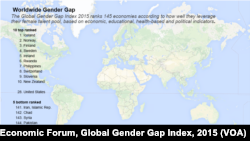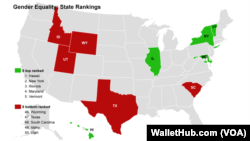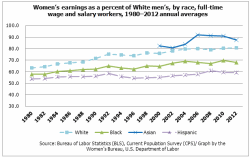The beginnings of International Women’s Day — a mass protest by thousands of women in New York City seeking better pay and working conditions, and the right to vote — have evolved into a day to take stock of the progress made toward gender equality as well as issues that still need to be addressed.
The United Nations views gender equality – the view that women and men have equal value and should be afforded equal treatment -- as a human right.
Yet despite a more than 100-year history for International Women’s Day, discrimination against women and girls continues worldwide in the form of gender-based violence and discrimination.
US ranking
The United States has made huge strides since that first march in 1908: women won the right to vote, they make up about half of the workforce and they now earn a higher percentage of college degrees than men, among other things.
However, the U.S. rates 28th out of 145 countries in an annual world ranking of equality for women.
The World Economic Forum "Global Gender Gap Report 2015" bases its equality ranking on economic, educational, health-based and political indicators.
The report, which was first published in 2006, shows progress has been made in the past decade, yet inequalities remain. In fact, it notes the gender gap has closed only 4 percent in the past 10 years, and at that rate, it would take 118 years to reach parity.
Iceland ranks No. 1 in the report, a position it has held for the past seven years. The Scandinavian countries – Norway, Sweden and Finland – as well as Ireland round out the top five countries. At the lower end, Yemen ranks as the least equal country for women.
Wages, politics
The U.S. fell eight places in 2015, with the report citing a slight drop in wage equality for similar work and fewer women in leading government positions.
While former Secretary of State Hillary Clinton is a front-runner in the Democratic presidential nominating race this year, the U.S., with women holding just 26.1 percent of high government positions, ranks 29th in the world, according to a U.N. report, "Women in Politics: 2015."
It fares worse regarding congressional seats. The United States ranks 73rd -- tying with Panama -- with women holding just 19.3 percent of the seats in the U.S. Congress – 84 in the House and 20 in the Senate.
While the U.S. does well regarding three criteria of the gender gap report, “the political representation of women in this country is abysmal,” Keshet Bachan, a girl's empowerment expert in Washington, D.C., told VOA.
“Just for comparison, Rwanda’s female representation to their [parliament] is over 60 percent, and in the Netherlands it’s almost 40 percent,” Bachan said. “We’ve never had a female president, which further drops our score.”
Leadership in business
The lack of gender equality extends to women in positions of leadership in U.S. businesses as well.
Just 20 years ago, there were no female CEOs of Fortune 500 companies, according to the Pew Research Center. In January 2015, Pew counted 26 women – 5.2 percent -- serving as CEOs of such companies.
However, women held nearly 17 percent of positions on company boards, according to 2013 data, up from nearly 10 percent in 1995.
In November 2014, women accounted for nearly half of the U.S. workforce – 47 percent. The number of working women 16 and older steadily grew for three decades, increasing from 39 percent in 1965 to 60 percent in 1999, Pew found. But the number fell to 57 percent by November 2014.
Education has been proven to be a strong equalizer between men and women, yet globally, nearly half a billion women cannot read and 62 million girls are denied an education, according to UNICEF.
International Women's Day: Benefits of Educating Girls
Educating girls
International Women's Day, while initially focused on women in the workplace, has evolved into a day to take stock of the progress made toward gender equality as well as issues that still need to be addressed.
Education has been proven to be a strong equalizer between men and women yet, globally, nearly half a billion women cannot read and 62 million girls are denied an education, according to UNICEF.
A report on girls’ education noted that girls are kept from school for many reasons:
- Poverty
- Institutional and cultural barriers
- Pressure for early marriage
- Lack of safety in getting to school
- Lack of separate latrines for boys and girls
- Sexual harassment and gender-based violence in schools
- Domestic work overload
If girls receive an education, it leads to:
- A decrease in child marriages by 64 percent
- A decrease in maternal mortality by 70 percent
- More children surviving past the age of 5
Source: UNICEF
However, education is an area where U.S. women have surpassed men. Since the 1990s, women have outnumbered men in college enrollment and completion rates, a Pew study found in 2013. Thirty-seven percent of women ages 25-29 had at least a bachelor’s degree, compared with 30 percent of men the same age, according to Pew.
College degrees
Women are also more likely to continue in education after receiving a bachelor’s degree: in 2012, women earned 60 percent of all master’s degrees and 51 percent of all doctorates; in 2013, women earned 36 percent of master of business administration degrees, according to the Pew study.
However, despite the gains in education, a gender wage gap persists, and is even wider for minority women.
The median weekly earnings for full-time female workers were about 80.4 percent of men’s earnings, according to fourth-quarter 2015 statistics by the U.S. Department of Labor.
In 2014, African-American women were paid 63 percent of what white men were paid, while Hispanic women were paid just 54 percent, according to a survey by the American Association of University Women (AAUW), a group that advocates for equity and education for women and girls.
In 1979, U.S. women earned about 62 percent as much as men in the same position, the Department of Labor said.
AAUW's report, "The Simple Truth About the Gender Pay Gap," found the wage gap has narrowed in the past 30 years due largely to more women furthering their education and entering the workforce.
Nationwide, the pay gap was smallest in Washington, D.C., where women were paid 90 percent of what men were paid in 2015, according to the American Community Survey, the ongoing statistical survey by the U.S. Census Bureau. The pay gap was largest in Louisiana, where women were paid 65 percent of what men were paid.
International Women's Day: Wage Factbox
Gender Wage Gap
- The median weekly earnings for full-time female workers were about 80.4 percent of men’s earnings, according to fourth-quarter 2015 statistics by the U.S. Department of Labor.
- African-American women were paid 63 percent of what white men earned in 2014, while Hispanic women were paid only 54 percent, the American Association of University Women, or AAUW reported.
- Earnings for both female and male full-time workers tend to increase with age, with a plateau after 45 and a drop after age 65. Women typically earn about 90 percent of what men are paid until they hit age 35. After that, median earnings for women are typically from 76 to 81 percent of what men are paid, according to the AAUW.
- As a rule, earnings climb as years of education increase for both men and women; however, while more education is a useful tool for increasing earnings, it is not effective against the gender pay gap. At every level of academic achievement, women’s median earnings are less than men’s.
- The gender pay gap persists across educational levels, even among college graduates, AAUW reported. As a result, women who earn college degrees are less able to pay off their student loans promptly, leaving them in debt longer than men.
- In 2014, the wage gap was smallest in Washington, D.C., where women were paid 90 percent of what men earned, and largest in Louisiana, where women earned 65 percent of what men were paid, according to the U.S. Census Bureau's American Community Survey.
Sources: U.S. Department of Labor; American Association of University Women: "The Simple Truth About The Gender Pay Gap"; the American Community Survey; U.S. Census Bureau
Advances made
In one of his first acts in office in 2009, President Barack Obama signed into law the Lilly Ledbetter Fair Pay Act, which prohibits sex-based wage discrimination. However, Congress has not passed the Paycheck Fairness Act, which would make it easier for women to challenge wage disparities.
“We’ve made strides in closing the pay gap, but we could do more,” Bachan said, referring to a report earlier this month by researchers at Accenture that said becoming adept at digital technology would help women close the gender gap in the workplace. "So that's the good news," she said.
"The bad news is that women's health in the U.S. is under constant threat, especially their access to comprehensive sexual and reproductive health and family planning. The campaign against Planned Parenthood, and the way states like Texas are making it harder for women to access abortion clinics. These are direct threats to our ability to make informed choices freely about whether, when and how many children we want to have," Bachan said.
"In terms of international laws, this is a basic minimum standard, and yet in the U.S. it's so highly politicized it's constantly being undermined," she told VOA.
Twenty years ago, a global gathering organized by the United Nations yielded what many consider a defining moment in the ongoing fight for gender equality.
Hillary Clinton, who was then the first lady of the United States, took the stage in Beijing and, in a 19-minute address, laid out a simple but soaring equation. "Human rights are women’s rights and women’s rights are human rights, once and for all," she said as applause erupted.
Her speech – delivered September 5, 1995, at the U.N. Fourth World Conference on Women – distilled the concerns brought forward by 5,000 official delegates and at least as many other participants.
Conference history
They challenged limits on women's and girls' education and health care, including reproductive health. Disparities in economic security, wages and inheritance rights. Violence against women, from domestic abuse to female circumcision to human trafficking.
This fourth women's conference made history, 20 years after the first, by securing the pledges of 189 world leaders to help females attain equality. Leaders committed to an action plan setting benchmarks and ensuring that women have "a full and equal share in economic, social, cultural and political decision-making" in public and private life.
"There was anticipation. There was excitement, too," recalled former U.S. Representative Connie Morella, who had led a small, bipartisan congressional delegation to the conference.
International Women's Day Factbox
International Women's Day: Resources
UN: Planet 50-50 by 2030: Step It Up for Gender Equality
Follow #IWD2016 on Twitter.
U.S. President Barack Obama's proclamation
First lady Michelle Obama on Women Veterans
U.S. Library of Congress photo gallery commemorating IWD
The Republican said she "felt the eyes of the world needed to look at what was happening to women.... I knew that my sisters in other parts of the world needed to have the protections I needed to have. In most instances, they needed them even more."
As Clinton noted in her 1995 remarks: "What we are learning around the world is that if women are healthy and educated, their families will flourish. If women are free from violence, their families will flourish. If women have a chance to work and earn as full and equal partners in society, their families will flourish. And when families flourish, communities and nations do as well.
"That is why every woman, every man, every child, every family, and every nation on this planet does have a stake in the discussion" – and in reaching those goals, she said.
Bachan is also optimistic that the goal of gender equality can be reached.
“The biggest win we could see is in encouraging more girls and young women to study STEM (science, technology, engineering and math) subjects and enter the tech industry. The stereotypes that discourage girls from studying engineering or mathematics are changing rapidly," she said, adding it is also up to tech companies to eliminate bias in their hiring practices.
"At the very end of that pipeline we still need companies to be more female friendly," Bachan said. "It's still very much a tech-bro space which alienates women. I'm optimistic, though, given the rise of girls and women in this industry, and looking to other sectors like law or female doctors, where we've seen huge increases in female representation in the past few decades means it can be done."
International Women’s Day was first observed in 1909, but it wasn’t observed by the United Nations until 1975. It's now celebrated in more than 25 countries around the world, from Afghanistan to Russia.
In 1981, the U.S. Congress established National Women’s History Week to be commemorated the second week of March, expanding the observation to a women’s history month in 1987.
Events have taken place in the days leading up to Tuesday’s official day of recognition, when events are scheduled throughout the U.S. and the world.
Carol Guensburg contributed to this report.
PHOTO GALLERY: International Women's Day events



















